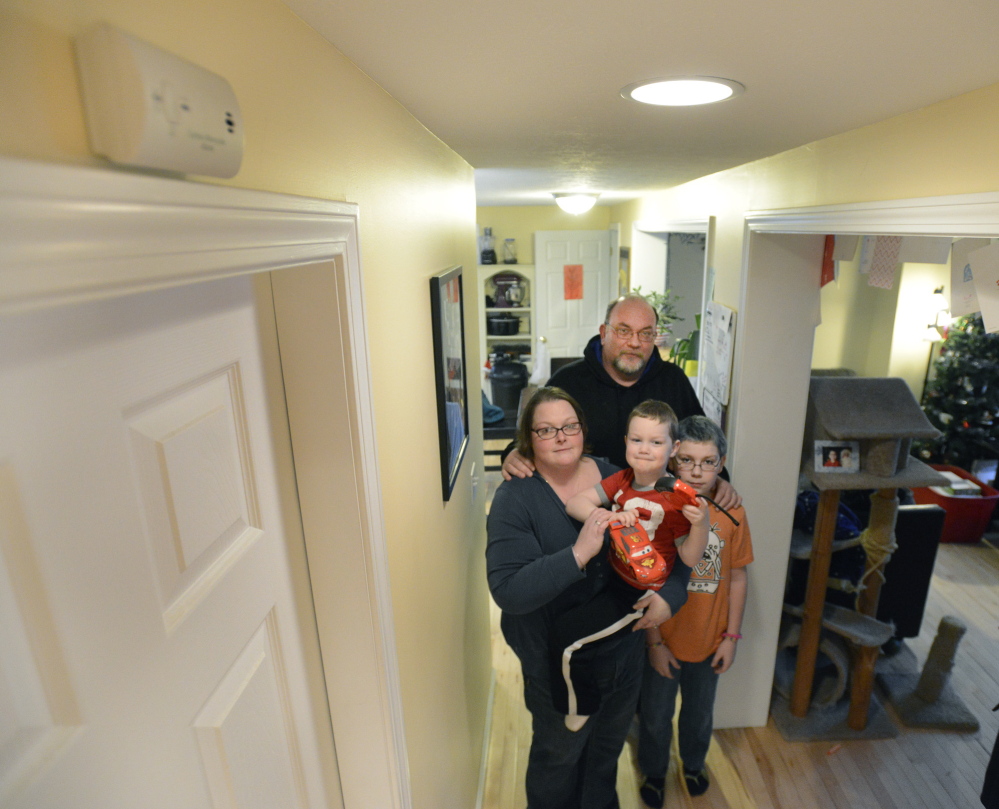BIDDEFORD — When Heather Mills hears news reports of carbon monoxide poisonings, she flashes back to the day her family almost died.
“Carbon monoxide sneaks in real fast and you don’t even know it,” she said of the odorless gas that filled her home in February and sent her whole family to the hospital in ambulances. “I’ve never been through anything so scary as watching my kids sit there in the hospital on oxygen.”
The Mills family – Heather, her husband, Bob, who is a city councilor in Biddeford, and their two children – and a family friend were among the 100 or so Mainers who end up in the hospital each year with carbon monoxide poisoning. Experts say the situation can quickly turn deadly, but can be prevented easily with proper use of heat sources and generators.
The Maine Center for Disease Control and Prevention is investigating four separate carbon monoxide poisonings related to this week’s ice storm, including the death Tuesday of a man from Knox, in Waldo County.
Vermont and Michigan each reported one carbon monoxide death during the ice storms that moved across the region, and there were three more deaths in eastern Canada this week.
State officials say Mainers must be careful when they use generators, and must plan ahead to avoid exposure to the odorless, invisible fumes that can quickly reach lethal levels.
Since 2005, Maine has had an average of 100 carbon monoxide poisonings each year, including a high of 153 in 2008, according to the CDC. Andrew Smith, the state toxicologist, said Maine usually has one to five deaths from carbon monoxide poisoning each year.
More than 400 people die in the U.S. every year from accidental carbon monoxide poisoning, according to the CDC.
Timothy Woods, 50, of Knox, was found dead in his garage early Tuesday morning after he was exposed to carbon monoxide from a generator that was running inside, according to police.
Woods went into the detached garage to refill the generator with gasoline and was overcome by the exhaust. The doors to the garage were closed.
On Wednesday, an elderly couple in Whitefield were rushed to the hospital with carbon monoxide poisoning after running a generator in a garage under the living space in their home. They were found unconscious by a neighbor who went to check on them, said Lt. Rand Maker of the Lincoln County Sheriff’s Department.
The man, 83, was taken by helicopter to MaineGeneral Medical Center in Augusta. The woman, 84, was taken to the same hospital by ambulance. Rand said Thursday that both were still hospitalized but their conditions were improving.
Smith, the state toxicologist, said most carbon monoxide poisonings in Maine occur in the winter and are related to improper use of generators when the power goes out. An enclosed space like a garage or a cellar bulkhead can fill with carbon monoxide quickly when a generator is running inside.
Smith said generators should be run at least 15 feet from houses.
“A single generator can produce as much carbon monoxide as the exhaust from 100 automobiles,” he said. “You wouldn’t want to leave 100 automobiles running in your basement or garage. Levels rapidly build up to deadly, as we’ve seen.”
In February, the Mills’ house in Biddeford filled with carbon monoxide when a propane heat vent got blocked by drifting snow.
Bob Mills said he had kept the vents on the side of his house clear, but a blizzard blanketed the city with snow and he didn’t realize that drifts were high enough to block them again.
As the family and their friend prepared to take a nap, Heather Mills noticed a ringing in her ears. Her son Trenton, 11, said his ears were ringing, too, and he felt sick to his stomach. Cooper, now 4, couldn’t walk by himself and complained of feeling sick.
Heather Mills knew that something was seriously wrong and rushed everyone out of the house. Bob Mills called 911 and, as rescuers arrived, collapsed into the arms of a fire lieutenant.
Their combined smoke-carbon monoxide detectors never went off.
The family spent the next four hours getting oxygen in the emergency room. They said it was a month before the headaches and nausea finally went away. They were left with costly medical bills and a shaken sense of security.
The family has since installed two more carbon monoxide detectors in their home, and Bob Mills has spoken publicly, sometimes at the request of the fire department, about the dangers of carbon monoxide poisoning.
“It was pretty traumatic to think we all could have been dead within minutes,” he said.
Gillian Graham can be contacted at 791-6315 or at:
ggraham@pressherald.com
Twitter: @grahamgillian
Send questions/comments to the editors.




Success. Please wait for the page to reload. If the page does not reload within 5 seconds, please refresh the page.
Enter your email and password to access comments.
Hi, to comment on stories you must . This profile is in addition to your subscription and website login.
Already have a commenting profile? .
Invalid username/password.
Please check your email to confirm and complete your registration.
Only subscribers are eligible to post comments. Please subscribe or login first for digital access. Here’s why.
Use the form below to reset your password. When you've submitted your account email, we will send an email with a reset code.